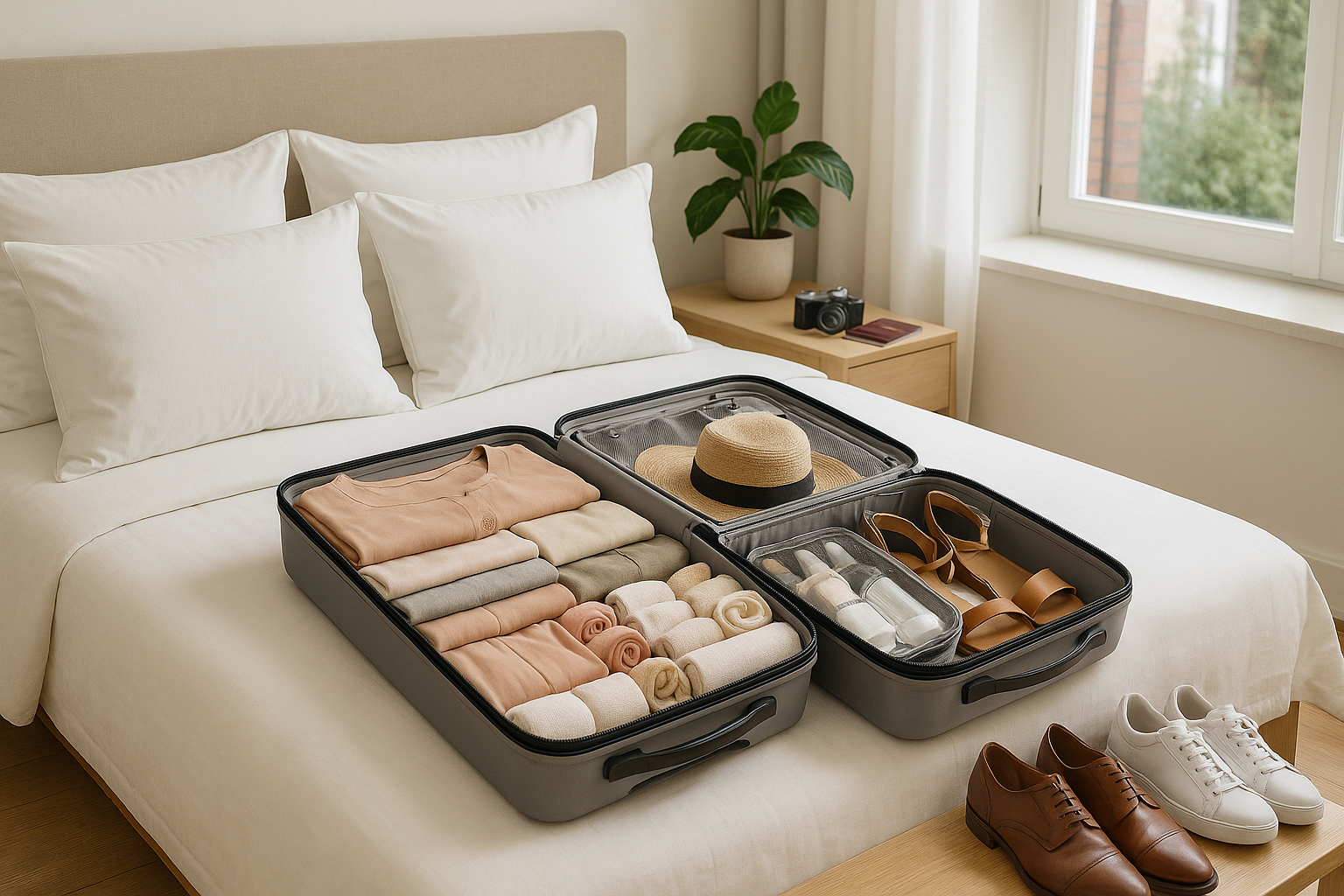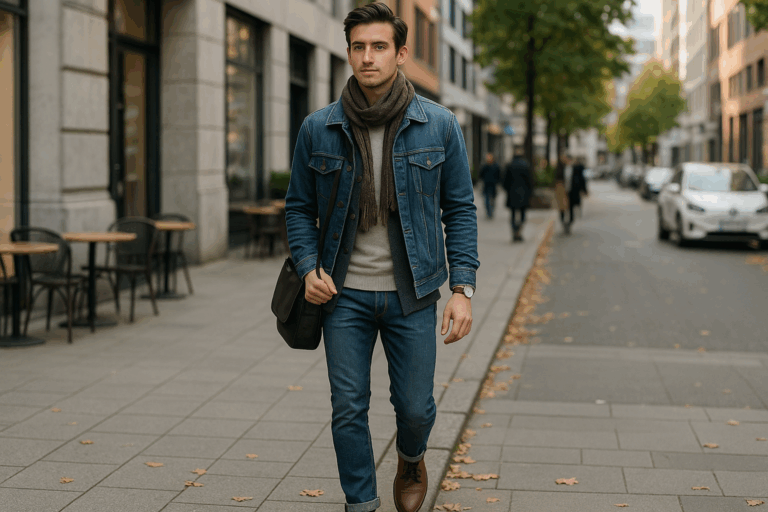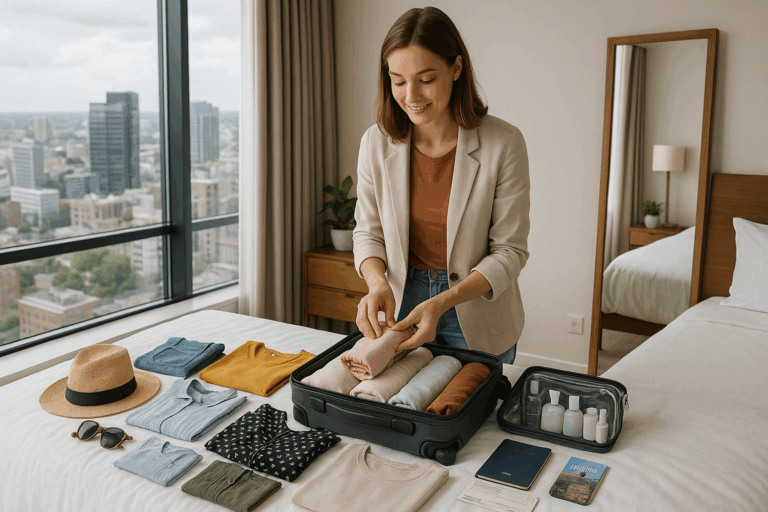One aspect that has remained a constant challenge for many, however, is the art of packing. How do you fit everything you need into a compact suitcase without sacrificing style or variety? That’s where this comprehensive guide comes in. In this article, we’ll dissect the nuances of ‘Packing Perfection: Streamlining Your Suitcase Without Sacrificing Style or Variety’.
Whether you’re a seasoned jet-setter or a first-time traveller, the process of packing your suitcase can often feel like a daunting task. What items do you need? How many outfits are too many? Can you fit in that extra pair of shoes? While these are valid questions, they often lead to overpacking, underpacking, or inefficient packing.
So, how can you ensure you have everything you need, all neatly packed into your suitcase? The answer is a blend of strategic planning, organization skills, and a touch of creativity. Our goal in this guide is to arm you with practical tips and techniques that will help you optimize your suitcase space, while still maintaining a variety of stylish options for your journey.
We’ll delve deep into the realm of travel essentials, providing you with a checklist of must-haves for any trip. Next, we’ll tackle the concept of capsule wardrobes, demonstrating how a few versatile pieces can create a multitude of outfit options. Finally, we’ll explore the practical side of packing – how to fold, roll, and arrange your items to maximize space.
Additionally, we’ll touch on the role technology plays in modern packing strategies. From travel-size gadgets to smart luggage options and packing apps, technology has introduced innovative solutions that can make packing more efficient and hassle-free. Embracing these advancements could revolutionize the way you pack, enabling you to travel lighter and smarter.
While the topic of suitcase packing may initially seem mundane or trivial, the impact of a well-packed suitcase extends beyond mere convenience. It can influence your travel experience, dictating how comfortable you feel during your trip, how easily you can navigate your destination, and how adaptable you can be to unexpected situations. Therefore, mastering the art of packing is not just a practical skill, but an essential component of travel itself.
Through the course of this article, we’ll take you on a journey that goes beyond the confines of your suitcase. We’ll equip you with knowledge and skills that can streamline your packing process, saving you time, reducing stress, and enabling you to make the most of your travels. So, buckle up and prepare to redefine your packing experience.
Ready to embark on this journey towards packing perfection? Let’s get started.
Packing Made Easy: Building an Efficient and Stylish Suitcase
The art of packing a suitcase efficiently while maintaining a sense of style and variety can be a daunting task for many. The struggle often lies in choosing which clothes to pack, how to fold them properly to avoid wrinkles and save space, and how to ensure you have enough outfits to cover all the possible scenarios you might encounter on your trip. In this article, we will delve into the best practices and strategies to help you pack like a pro without sacrificing style or variety.
Before we get started, we highly recommend watching this video tutorial by Sonia Gil titled “How to Pack a Suitcase Efficiently – Best Travel Packing Tips” on her YouTube channel ‘Sonia’s Travels’. This video offers a comprehensive guide on how to pack efficiently, from selecting clothes to fitting them into your suitcase. Don’t forget to check it out!
Selecting Your Travel Wardrobe
When it comes to packing for travel, the first and foremost step is to select your wardrobe wisely. Keep in mind the duration of your trip, the expected weather, and the activities you plan to do. A versatile wardrobe with a variety of mix and match options is a great approach. Try to choose pieces that you can layer, like light jackets or cardigans, to adapt to changing weather conditions.
In terms of color palette, it is often helpful to stick to neutral tones such as black, white, grey, or beige, as they can easily be combined with other colors. However, don’t forget to pack a few statement pieces to give your outfits a pop of color and style.
A great strategy to ensure variety in your travel wardrobe is to utilize a capsule wardrobe strategy. A capsule wardrobe is a collection of a few essential items of clothing that don’t go out of fashion. Here’s a video that explains this concept in detail: “The Capsule Wardrobe: How to Reduce Your Closet to 37 Pieces” by ‘Downshiftology’ on YouTube.
Folding Techniques to Maximize Space
The next crucial step is to fold your clothes in a way that optimizes the space in your suitcase. There are several folding techniques you can use, including the traditional fold, the roll method, and the bundle method. Each of these techniques has its pros and cons, as you can see in the table below:
| Folding Technique | Pros | Cons |
|---|---|---|
| Traditional Fold | Easy to do, works well for heavy and stiff items like jeans and jackets. | Can lead to wrinkles if not done properly. |
| Roll Method | Saves space, reduces wrinkles for most items. | Not ideal for stiff or heavy items as it can create bulky rolls. |
| Bundle Method | Great for reducing wrinkles, especially for formal wear. | Can be complicated to do, requires careful planning. |
Understanding the benefits and drawbacks of each method can help you decide the best approach for your packing needs. We recommend experimenting with these techniques to find what works best for you.
Maximizing Variety Without Overpacking
One of the biggest challenges when packing for a trip is maintaining a variety of outfit choices without overpacking. This task can be especially daunting when you’re trying to adhere to airline luggage weight limits or if you simply don’t want to lug around a heavy suitcase. Fortunately, with some strategic planning, you can ensure a diverse travel wardrobe without having to sacrifice style or overpack.
Adopting the Mix and Match Strategy
The key to maximizing variety in your travel wardrobe lies in the ability to mix and match your pieces. To do this effectively, opt for versatile items that can be paired in multiple ways. For instance, a black dress can be dressed up for a formal event, dressed down for casual sightseeing, or layered with a cardigan for a chilly evening. Similarly, a pair of jeans can be paired with a t-shirt for a casual day out or a button-down shirt for a slightly more formal occasion.
Layering for Style and Versatility
Layering is not just a great way to cater to changing weather conditions, but it’s also an excellent strategy to create different looks with the same pieces. For example, a simple tank top can take on a completely different look when layered with a blazer, cardigan, or scarf. Additionally, layering can help you keep warm in colder climates or in air-conditioned environments without requiring you to pack bulky items.
As you apply these techniques, always remember the goal is to create a travel wardrobe that is stylish, versatile, and practical. Be sure to watch this video by ‘Travel Fashion Girl’ on YouTube titled “10 Piece Packing List for Vacation” for more visual inspiration.
Ensuring a Well-Organized Suitcase
Now that we’ve covered the basics of selecting a versatile wardrobe and folding techniques, the final step is to organize your suitcase in a way that maximizes space and accessibility. Proper organization not only ensures that you can fit everything you need into your suitcase, but it also makes it easier to find what you need when you reach your destination.
Utilizing Packing Cubes
Packing cubes are a game-changer when it comes to suitcase organization. They come in different sizes and allow you to compartmentalize your items, making it easier to find what you need without having to rummage through your entire suitcase. Furthermore, packing cubes can help keep your clothes compact and minimize movement during transit, reducing the chance of wrinkles.
Strategic Placement of Items
How you arrange your items in your suitcase can also have a significant impact on space efficiency and accessibility. Here are a few tips:
- Place heavier items like shoes and toiletries at the bottom of your suitcase near the wheels. This will make your suitcase more stable and easier to maneuver.
- Roll your clothes and store them in packing cubes to keep them compact and wrinkle-free.
- Fill empty spaces, such as the insides of your shoes, with small items like socks or underwear.
- Keep items that you will need immediately upon arrival, like toiletries or a change of clothes, at the top for easy access.
To see these tips in action, be sure to watch “How to Pack a Carry-On Suitcase” by ‘Travel Fashion Girl’ on YouTube. It provides a practical demonstration of how to apply these packing strategies effectively.
Packing a suitcase efficiently while ensuring a stylish and versatile wardrobe may seem challenging, but with the right strategies, it can become an easy and even enjoyable task. We hope that this guide provides valuable insights to make your packing process smoother and more efficient. Safe travels!

Conclusion
In conclusion, we have journeyed together through a comprehensive exploration of some of the most critical aspects within the realm of Software Engineering and Information Technology. We have delved into intricate concepts, unraveled complex methodologies, and offered understandable explanations of highly technical processes.
We began our exploration with a clear definition of Software Engineering, elucidating its significance in our modern digital age. We shed light on the integral role it plays in designing, developing, and maintaining software systems that we interact with daily, from mobile applications to complex enterprise systems. We affirmed that the discipline’s primary goal is to ensure the production of high-quality software that meets user requirements and is maintainable, efficient, and reliable.
Subsequently, we delved into the phases of the software development life cycle, from requirement analysis and system design to implementation, testing, and maintenance. These stages, we stressed, are crucial in guiding the development process, ensuring that the final product aligns with the initial vision, and meets the desired quality standards.
Moving on, we discussed various software engineering models, including Waterfall, Agile, and DevOps, noting their unique advantages and how they can be best applied. We underscored the significance of choosing the right model based on the project’s requirements and the team’s skills and dynamics.
We also delved into the vital role of testing in software engineering, discussing different testing types, including unit, integration, system, and acceptance testing. We affirmed that rigorous testing ensures that the software is bug-free, meets user requirements, and delivers an excellent user experience.
Our journey also took us through the essential tools in software engineering, ranging from Integrated Development Environments (IDEs) like Eclipse and Visual Studio to version control systems like Git. We highlighted the role these tools play in boosting productivity, enhancing collaboration, and ensuring version control.
Finally, we touched on the critical role of ethics in software engineering, discussing issues like user privacy, data protection, and professional conduct. We stressed that adhering to ethical standards is not just a moral obligation, but also crucial for maintaining trust and credibility in the field.
By reaching the end of this article, you have gained a comprehensive understanding of these critical aspects within the field of Software Engineering and Information Technology. But remember, the learning doesn’t stop here. Keep exploring, keep questioning, and continue to broaden your horizons.
This knowledge equips you with the ability to appreciate the complexity of the software systems we use daily, and, for those in the field, to produce software that genuinely adds value to the user and the wider society. I encourage you to apply what you’ve learned, share this knowledge with your peers, and engage in discussions that promote learning and growth.
For further reading, the Association for Computing Machinery (ACM) and the IEEE Computer Society offer numerous resources that can deepen your understanding of software engineering and IT.
I appreciate your time and attention and look forward to your feedback, comments, and insights. Together, let’s continue to demystify the world of Software Engineering and IT.



